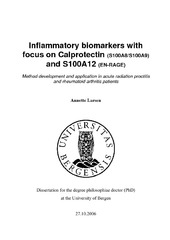| dc.description.abstract | Assessments of diseases are usually performed by a combination of clinical symptoms, signs and objective measurements. Biochemical markers of inflammation are important in evaluation of treatment of acute and chronic diseases. In this thesis we have focused on two inflammatory diseases: acute radiation proctitis and rheumatoid arthritis. We examined established and new biomarkers, with focus on two closely related proteins, calprotectin (S100A8/S100A9) and S100A12 (ENRAGE). These and other biomarkers were compared to clinical symptoms and signs with the aim of defining their usefulness in monitoring the course of the diseases. Characterizing the changes induced by radiation therapy to the pelvic region showed incongruent time profiles in symptoms, histological scoring of inflammation and biochemical measurements. Compared to the examination before start of radiation therapy, biopsies from rectal mucosa showed a maximal inflammation at the first examination during radiation therapy, while symptoms were at the most intense towards the end of treatment. Vitamin E concentrations in blood were significantly lower during treatment but returned to normal within a month. Calprotectin and lactoferrin concentrations in stool samples increased during therapy and were the most promising biomarkers for radiation proctitis in our study. Development of an ELISA immunoassay for the quantification of S100A12 in blood showed that calcium concentration influenced the estimated S100A12 concentrations. Various experiments led to the conclusions that the antibodies used in this assay could only recognize S100A12 when calcium were above a threshold and that S100A12 were found in many molecular sized complexes (oligomers) in blood. S100A12 was found to bind to heparin and this will be further examined in the future. Calprotectin and CRP in blood correlated with disease activity of rheumatoid arthritis. S100A12 was associated with a more severe disease course in terms of extra-articular disease manifestations and the presence of cardiovascular disease. S100A12 correlated with rheumatoid factor and anti-CCP and may thus be of prognostic value. In summary, radiation proctitis occurs in biopsies before symptoms are evident. This is important knowledge for studies with interventions to prevent development of late radiation enteropathy. Stool markers are at present the best suited objective means of assessing interventions. The quantification of S100A12 in blood samples are recommended to be done in serum samples, since both anticoagulants EDTA and heparin may influence conformational changes of S100A12 protein structure and hence the measured concentrations. The usefulness of S100A12 as a biomarker in rheumatoid arthritis and other inflammatory diseases warrants further examinations. | en_US |




